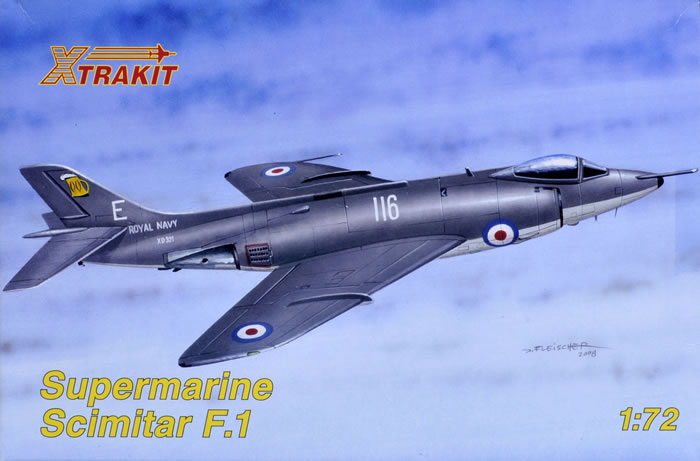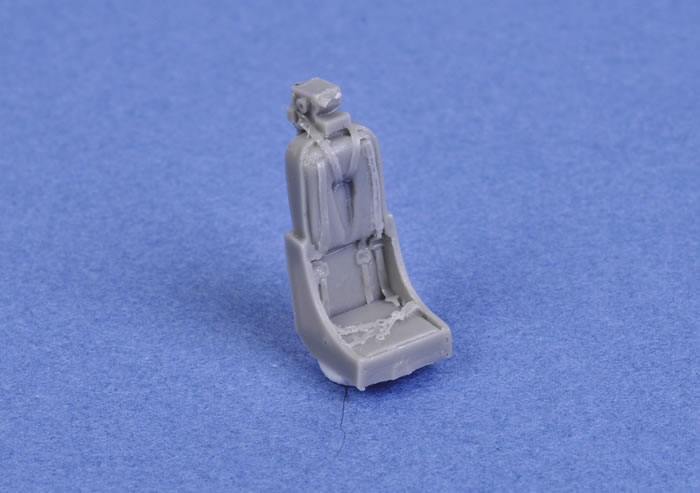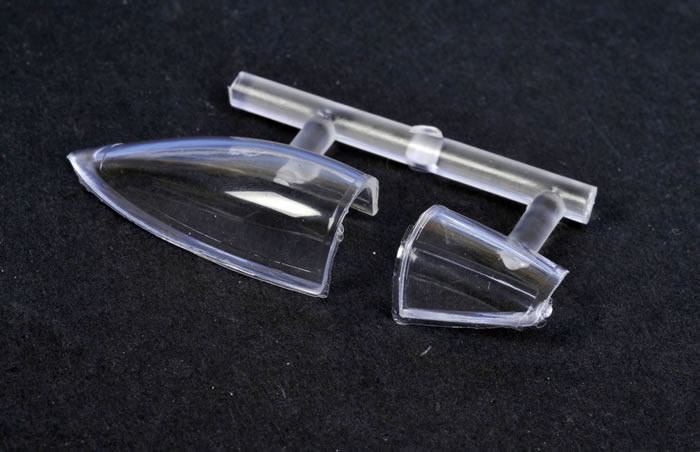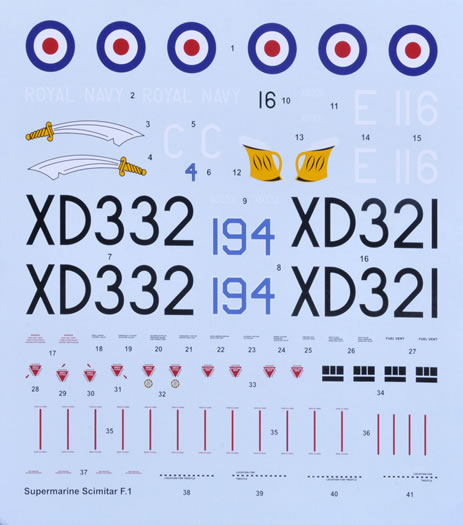|
Supermarine Scimitar F.1

Xtrakit, 1/72 scale
S u m m a r y |
|
Catalogue Number: |
Xtrakit XK72011 - Supermarine Scimitar F.1 |
|
Scale: |
1/72 |
| Contents and
Media: |
72 parts arranged on four sprues of grey styrene, two parts on a transparency sprue, two resin parts and decals for two subjects.t
|
| Price: |
GBP£17.99 available online from Hannants website |
| Review Type: |
FirstLook |
| Advantages: |
It’s an injection moulded Supermarine Scimitar! Finely engraved panel lines and control surfaces. Excellent decals. Type long desired by FAA modellers. |
| Disadvantages: |
A short run kit, hence.. no locating/alignment pins for the major parts. Flash on most parts. Some mould ejector towers and shrinkage dimples in awkward places. A surface blemish on the forward port fuselage. Not a kit for the novice. |
|
Conclusion: |
A limited run kit so experience will be required. Ony the basics provided but with some extra work and detailing this will be the basis for a fine model. |
Reviewed by Peter Mitchell
When I think of the company Supermarine three things generally spring to mind; graceful flying boats, racing float-planes and.... the Spitfire.
All of these successful and generally aesthetically pleasing designs came from the drafting board of one R.J. Mitchell (no relation to me).
Supermarine is not generally remembered for its jet designs, which tended to be neither aesthetically pleasing nor very successful.
So, I for one wonder how different the jet designs Supermarine would have turned out had R.J. Mitchell enjoyed the longevity of Hawkers Sir Sydney Camm who succeeded in producing a long line of elegant and successful designs that spanned decades and saw the evolution of flight from bi-planes through to the second generation of jet aircraft.
Of the three Supermarine jet designs that saw production; the scimitar was the last, probably the most successful and to my eye the best looking.
It was also to be the last aircraft of the Supermarine line.
The Scimitar design began in the mid 1940’s as an answer to an Admiralty requirement which required a jet powered carrier-borne aircraft equipped without landing gear in an attempt to save weight and simply land aircraft on a rubber deck.
When this requirement was found to be impracticable the design had landing gear added and was designated the type 508.
Submitted to the Admiralty in 1947 as a replacement for the Supermarine Attacker (the Royal Navys first jet fighter), the prototype first flew in August 1951 and after some modification (primarily to the nose and tail areas) the Supermarine Scimitar F.1 entered service in June 1958.
Initially 100 airframes were ordered, however with the promise of the future entry of the Blackburn Buccaneer, this order was reduced to 76 airframes.
In service the Scimitar equipped five squadrons of the Fleet Air Arm and was generally popular with its crews, possessing good handling below 25,000 ft. The type was also beset with design faults, possessing the unenviable record of requiring 1000 maintenance hours for every hour of flying time. On the ground it often dripped fuel and over the course of its relatively short eight year service life a phenomenal 39 (over half) were lost due to accidents, mostly upon landing. Consequently very few survived the scrap-yard and only three complete examples survive to the present day in museums.
The final role for the Scimitar in service was that of an in-flight refuelling buddy for the new Blackburn Buccaneer, since the early Buccaneers were insufficiently powered to be launched from carriers with a full fuel load.
With the exception of the ancient Frog kit, there has to my knowledge, only been two other options for kits of the Supermarine Scimitar produced in 1/72, these being the rather expensive CMR resin offering and the limited run Merlin kit.
I once had the opportunity to buy a second hand Merlin offering, however upon looking at the contents of the kit I decided to pass.
So, I was looking forward to the release of a decent Scimitar kit....
The kit comes in an end opening box with an attractive box art of an 800b Sqn Scimitar in flight. The side of the box states that the kit was manufactured by Vision Sword s.r.o. on behalf of H.G. Hannant Ltd.
The contents of my kit were packed in two zip seal plastic bags, the transparencies are packed separately to protect them from the larger sprues. The instructions are printed on both sides of two folded A4 pages and they feature a map of the kit parts on the sprues and provide colour call outs for most of the parts. The later features Xtracolour/Xtracrylix references only, however these can be easily converted to the modellers preferred paint system. A painting and decal placement guide for the two options included are also printed overleaf.
The short run nature of the kit and consequent lack of alignment pins means care will be required in obtaining the correct alignment at critical points.
The kit consists of four sprues of light grey styrene. There is flash on most of the parts and the surface detail consists of engraved panel lines that is, for the most part fit for purpose. The perforations on the fuselage airbrakes, a prominent feature of the real aircraft, have been over looked. Care will be required to drill these in their correct location just forward of the jet exhausts. There are a few rather prominent ejector towers in some awkward places and these will need to be removed if some of the larger parts are to fit together. The lower fuselage cannon ports are shallow and the inner two are faired over. Most photos I’ve seen of Scimitars in service have these ports prominently displayed open, however, it is true that the inner two ports were often faired over in aircraft equipped with missiles. So these may or may not need to be to be opened up depending on the aircraft modelled.
My example had a blemish on the port fuselage half that stretched from the mid cockpit, along the engine intake and ended at the exhaust exit point.
I’m not sure if this fault is common to all the kits in this production run or that in this case it was just not picked up by the manufacturer’s quality control, either way it will take some careful filling and sanding.
At the time of writing this review I did not have any scale plans. The general outline of the kit looks fine to my eye and the general dimensions seem correct without reference to definitive drawings.
Construction starts, as per usual, with the cockpit; here the modeller is provided with the basics and little more. There is a cockpit tub, instrument panel, joy stick and a seat.

No side console detail is provided, although to be fair the predominant colour will be black so it will be hard to make out any finer detailing when the cockpit is completed. Even so, this area will benefit from some extra detail since the kit transparencies are quite clear and as the canopy is in two pieces it affords the potential to have the canopy in the open position.

The engine air intake ducts are provided and these slide into the intakes. There are some prominent ejector towers in this area and these will require careful removal. The ducts are blanked off at the end by a fair representation of the Rolls Royce Avon engine turbine fronts. The exhaust nozzles, which are split horizontally, will require careful construction.
The wings are split horizontally and are not broken at the wing fold line. Should the modeller wish to produce the kit with the wings folded they will have to do some careful surgery. (I think the Scimitar looks better with the wings in the “closed down” position anyway). The instructions point out the anhedral sit of the wings and tail plane, however, they do not say what the angle should be. The attachment of the wings to the fuselage will also need strengthening since a very thin guide fillet at the wing root is the only item provided as a means of support at this junction. Separate wing fences are included, although these will need thinning.
Four wing ordinance pylons are provided, however the only ordinance included with the kit are two sets of wing drop tanks. The inclusion of other ordinance such as 1000 lb bombs, refuelling drogue, sidewinder or bullpup missiles would have been welcome additions.
The fuselage wheel wells are moulded closed and since this appears to be how most Scimitars seem to sit when parked, this can be overlooked. However the wing wheel wells are a little shallow and would benefit from some extra detailing. The landing gear and the arrestor-hook bay are adequate but lack finesse and there are some prominent shrinkage dimples in the middle of the arch in the forward landing gear and on the rims of the main wheels.
The wheel well arch can be fixed with a bit of work, however the main wheels would probably best be replaced by some resin items.
On a positive note, the decals are beautifully printed. The colour grades appear to be correct and the register is perfect. A wide range of stencils (and I think some spares) are provided and the detail is fine enough for even the small print to be legible.
The modeller is provided with the choice of two schemes, both in the standard RN camouflage scheme of extra dark sea grey over white. There appears to be some confusion regarding the aircraft listed in the heading and the ones featured in the decal sheet.
The first option is for Scimitar F.1 XD321, 116/E of 800b Sqn, HMS Eagle 1964-65. This is listed in the painting guide as 112/E, (112/E was in fact XD268).
The numbers “116” in white are also missing from the trailing edge of the wing flaps.
Clear photos of each aircraft exist and feature in Postwar Military Aircraft No. 7 (see references below)
The alternative is for Scimitar F.1 XD332, 194/C of 807 Sqn, HMS Ark Royal 1960-61. This is also listed differently in the painting guide, in this case as 192/R.
Most 807 Sqn aircraft during this period featured prominent numbers on the nose in black outlined in white, however, those aircraft seen at Farnborough in 1959 had similar numbers in light blue outlined in black. The decal sheet provides the numbers as light blue outlined in white.
The above reference features “194” in the light blue outlined in black version, however the serial for this aircraft is XD268.

The modeller will need to check their references in deciding which is correct.
Hopefully, Xtradecal will do what they did for the Sea Vixen with sheet X02577 and produce a decal sheet that provides sufficient decals to model virtually any of the Scimitars as they appeared in their eight years of service.
I was a little disappointed with this kit compared to Xtrakit’s recent releases (their Gloster Meteor for example).
It is true that modellers finally have a mainstream 1/72 Supermarine Scimitar, but this is not a kit for the novice modeller and I can’t help but feel it was a bit of a missed opportunity.
I was hoping for a bit more. You get the basics but that’s about it. However, with some extra work and detailing this will be the basis for a fine model.
Recommended for those who really want a Scimitar F.1.
It is my hope that someone at some stage in the near future will produce the other Supermarine jets, the Attacker and the Swift.
References
Xtrakit instruction sheet
Wikipedia: Supermarine Scimitar
Scale Aircraft Modelling Vol. 13, No. 2. November 1990 p54-65.
-An excellent source of Scimitar photos and profiles. Features a lovely colour photo of a Scimitar in flight on the cover.
Scale Aircraft Modeller International Vol. 3, No. 9. September 1997 p580-583.
-Features an article on building the 1/48 Dynavector Scimitar.
Postwar Military Aircraft No. 7 Supermarine Attacker, Swift and Scimitar” by Philip Birtles. Ian Allan Publications 1991.
Sample purchased by reviewer
Xtrakits, Xtraparts and Xtradecals are
all
available online from Hannants'
website
Text Copyright © 2009 by Peter Mitchell
Images Copyright © 2009 by Brett Green
This Page Created on 20 September, 2009
Last updated
20 September, 2009
Back to
HyperScale Main Page  |
